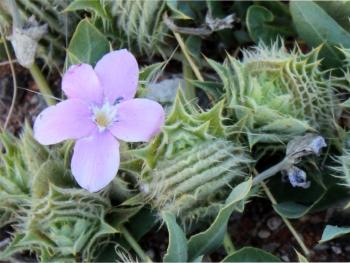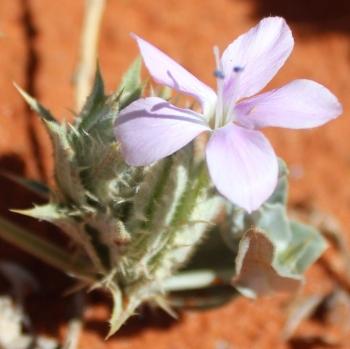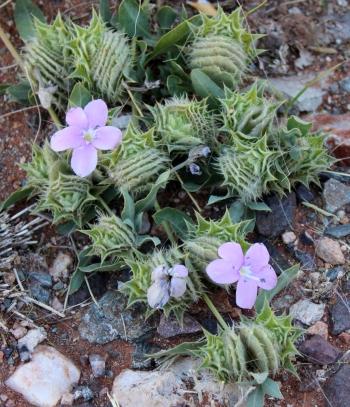Barleria lichtensteiniana
Barleria lichtensteiniana Nees
Family: Acanthaceae
Common names: little porcupine (Eng.); rolvarkie, klapperbossie (Afr.)
Introduction
Barleria lichtensteiniana, the jewel of the Kalahari.

Description
Description
Barleria lichtensteiniana is a trailing herb up to 200 mm high. The stems grow out of a woody rootstock and are covered with white hairs. The leaves are lanceolate and both sides are covered with hairs, which gives the leaves a grey-silky appearance. The leaf margins are entire and the leaf tapers into a long petiole. The inflorescence consists of 3–6 mauve flowers, densely packed, and the middle flower always opening first. The corolla is 2-lipped;the upper lip is 4-lobed and the lower lip 1-lobed.

The calyx lobes (outermost sterile appendix of a flower) are ovate and covered with hairs and the network of veins is very prominent. The margins and apex of the posticous lobe (lobe closest to the stem), are spiny and the margins of the anticous lobe (lobe facing away from the stem) are entire and the apex not spiny.

The bracteoles (secondary bracts) are oblong, covered with long hairs and the margins and apex are spiny. The bracteoles are overlapping to support the calyx lobes.

The fruit capsule is elliptic and has 4 seeds per capsule.

Plants flower from midsummer to midwinter (January to June), during which time flowers appear sporadically.
Conservation Status
Status
According to the Red List of South African plants, the conservation status of this plant is Least Concern (LC).

Distribution and habitat
Distribution description
Barleria lichtensteiniana occurs naturally in the Northern Cape in South Africa, and in Namibia, growing in deep sandy soils of the Kalahari, in full sun. Plants are tolerant to light frost and are drought resistant.
Derivation of name and historical aspects
History
The genus Barleria is named after a Dominican monk and French botanist Jacques Barrelier. This species is named after Martin Hinrich Lichtenstein (1780–1857), a German physician, naturalist and botanical explorer. The Afrikaans name rolvarkie is most likely a contraction of rolystervarkie, meaning ‘rolling miniature porcupine’ and refers to the spiny inflorescences that are rolled along the ground by the wind when dried.
The genus Barleria belongs to the family Acanthaceae, containing about 250 genera and 2 500 species. The genus Barleria is very large, comprising about 300 species, growing mainly in Africa and Asia (Old World), but one species extends into the New World .Examples of species in the genus include, Barleria obtusa, B. albostellata and B. rotundifolia.

Ecology
Ecology
Barleria lichtensteiniana is pollinated by insects and attracts various species of butterflies. Ripe seed capsules explode when moistened and so distribute the seed. The dried inflorescences may become detached from the plant and are rolled about in the wind, which further disperses the seeds.
Uses
Use
Barleria lichtensteiniana does well in a sunny spot in the garden and does not need plenty of water.

Growing Barleria lichtensteiniana
Grow
Barleria lichtensteiniana can be propagated from seed. Harvest the ripe capsules before they explode and expel the seeds. Use 1 part coarse river sand and 2 parts potting medium, for germination. Plant the seeds 2 cm apart in the medium and cover them lightly with the growing medium. Place the seed tray in a shady spot and water well once a week. Germination starts to take place in 7 days. Transplant the seedlings when they are 5 cm in size.
Barleria lichtensteiniana does not grow from cuttings; seed is the only method to multiply plants.
There are no specific pests and diseases that affect Barleria lichtensteiniana.
References
- Clarke, H. & Charters, M. 2016. The illustrated dictionary of southern African plant names. Flora & Fauna Publications Trust, Jacana, Johannesburg.
- Kamundi, D.A. 2006. Barleria lichtensteiniana Nees. National Assessment: Red List of South African plants version 2017.1. Accessed on 2018/05/17.
- Little, J. R. & Jones, C.E. 1980. A dictionary of botany. Van Nostrand Reinhold Compony, New York, Cincinnatti, Toronto, Melbourne.
- Plug, C. Accessed 23 May 2018. Lichtenstein, Dr Martin Hinrich Carl. S2A3 Biographical Database of Southern African Science. http://www.s2a3.org.za/bio/Biograph_final.php?serial=1681
- Smith, C.A. 1966. Common names of South African plants. Memoirs of the Botanical Survey of South Africa No. 35. Government Printer, Pretoria.
Credits
Willem Froneman
Lowveld National Botanical Garden
June 2018
Plant Attributes:
Plant Type: Shrub
SA Distribution: Northern Cape
Soil type: Sandy
Flowering season: Late Summer, Autumn, Winter
PH: Acid, Neutral
Flower colour: Mauve/Lilac
Aspect: Full Sun
Gardening skill: Average
Special Features:
Horticultural zones







Rate this article
Article well written and informative
Rate this plant
Is this an interesting plant?
Login to add your Comment
Back to topNot registered yet? Click here to register.